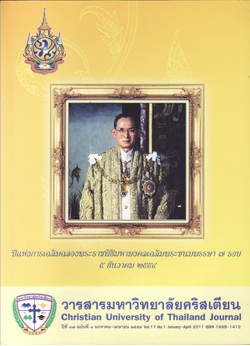ผลของพรีคูลิ่งเทคนิคต่อสมรรถภาพการใช้ออกซิเจนสูงสุดของนักกีฬา ฟุตบอลเยาวชน โรงเรียนพระปฐมวิทยาลัย จังหวัดนครปฐม
บทคัดย่อ
ในการแข่งขันฟุตบอลของนักกีฬาฟุตบอลที่ต้องใช้ระยะเวลานาน ในสภาพอากาศที่ร้อนส่งผลให้อุณหภูมิของร่างกายเพิ่มสูงขึ้นทำให้เกิดอาการต่างๆ ซึ่งจะเป็นปัญหาที่สำคัญที่ทำให้นักกีฬาเมื่อยล้าและทักษะความสามารถของนักกีฬาลดลง การวิจัยครั้งนี้มีวัตถุประสงค์ เพื่อศึกษาผลของการใช้พรีคูลิ่งเทคนิคต่อสมรรถภาพการใช้ออกซิเจนสูงสุดของนักกีฬาฟุตบอลเยาวชนในสภาพอากาศร้อนชื้น ในกลุ่มตัวอย่าง 30 คน ทดสอบวันที่ 1 ผู้เข้าร่วมการทดสอบได้รับการตรวจความดันโลหิต อัตราการเต้นของหัวใจ อัตราการหายใจ อุณหภูมิร่างกาย ระดับความเหนื่อย (RPE) ก่อนและหลังการทดสอบ อบอุ่นร่างกายและยืดกล้ามเนื้อ 5 นาที จากนั้นให้ผู้ร่วมการทดสอบปั่นจักรยานและวิ่งตามระยะ (Cycling and Intermittent sprint) ตามวิธีการของ แคสเชิลและคณะ และทำการทดสอบสมรรถภาพการใช้ออกซิเจน (Multistage Fitness Test) ในการทดสอบวันที่ 2 ให้ผู้เข้าร่วมการทดสอบใช้พรีคูลิ่งเทคนิควิธีแช่เท้าในน้ำเย็นที่อุณหภูมิ 28 องศาเซลเซียสเป็นเวลา 20 นาที จากนั้นให้ผู้ร่วมการทดสอบปั่นจักรยานและวิ่งตามระยะ ตามวิธีการของพอลและคณะ แล้วทำการทดสอบสมรรถภาพการใช้ออกซิเจนเช่นเดียวกับวันแรก ผลการทดลองพบว่า การใช้พรีคูลิ่งเทคนิคเพิ่มสมรรถภาพการใช้ออกซิเจนสูงสุดให้กับนักกีฬาได้อย่างมีนัยสำคัญทางสถิติ ลดอุณหภูมิกายและระดับความเหนื่อย (RPE) อย่างมีนัยสำคัญ (P < 0.05) จากผลการศึกษาสามารถสรุปได้ว่า การใช้พรีคูลิ่งเทคนิคเพิ่มสมรรถภาพการใช้ออกซิเจนสูงสุดในนักกีฬาฟุตบอลเยาวชนขณะเล่นอย่างต่อเนื่องในสภาพอากาศที่ร้อนชื้นได้
เอกสารอ้างอิง
ประโยค สุทธิสง่า. (2538). ทักษะฟุตบอล. กรุงเทพ : โรงพิมพ์ไทยวัฒนาพานิช.
ฟอง เกิดแก้ว. (2520). การพลศึกษา. กรุงเทพ : พิทักษ์อักษรการพิมพ์.
วรวิทย์ รัตนเสถียรกิจ. (2552). ผลของการแช่น้ำเย็นที่มีผลต่อการฟื้นสภาพและความสามารถทางกาย. วิทยานิพนธ์ปริญญาวิทยาศาสตรมหาบัณฑิต สาขาวิชาวิทยาศาสตร์การกีฬา มหาวิทยาลัยศรีนครินทรวิโรฒ.
Arngrimsson S.A., Petitt D.S., and Stueck M.G. (2003). “Cooling vest worn during active warm-up improves 5-km run performance in the heat”. J Appl Physiol. 96 : 1867-1874.
Bangsbo J., Laia F.M. and Krustrup P. (1991). “Activity profile of competition soccer”. Can. J. Sport Sci. 16 : 110-116.
Buchheit M., Peiffer J.J., Abbiss C.R. (2008). “Effect of cold water immersion on repeat cycling performance and thermoregulation in the heat”. Journal of Sports Science. March : 26(5) : 431-440
Castle P.C., et al. (2006). “Precooling leg muscle improves intermittent sprint exercise performance in hot, humid conditions”. J Appl Physiol. 100 : 1377-1384.
Crowe M.J., O'Connor.and D., and Rudd D. (2006). “Cold water recovery reducesanaerobic performance”. Sport Medicine. 28 : 994-998.
Drust B., Cable N.T. and Reilly T. (2000). “Investigation of the effects of the precooling on the physiological responses to soccer-specific intermittent exercise”. Eru J Appl Physiol. 81(1-2) : 11-17.
Ellis Lindsay et al. (2000). Protocols for the Physiological Assessment of Team Sport Players. In J,C. Gore (ed). South Australia: Human Kinetics
Janes Bangsbo F., Marcello laia and Peter Krustrup (2008). “The Yo-Yo Intermittent Recovery Test A Useful Tool for Evaluation of Physical Performance in Intermittent Sports”. นิตยสารกีฬา. 38 (1) : 37-51.
Quod M.J, Martin D.T, Laursen P.B. (2006). “Cooling athletes before competition in the heat: comparison of techniques and practical considerations”. Sports Med. 36(8) : 671-682.
Tintinalli J.E., Kelen G.D., and Stapczynski J.S. (2004). Emergency Medicine a comprehensive study guide, 6th ed. Philadelphia : McGill-Hill. 1183-1190.
Vaile, J., Halson, S., Gill, N. and Dawson, B. (2008). “Effect of Hydrotherapy on the recovery on fatigue”. International Journal of Sports Medicine. 29: 539-544.
Vicario S. et al (2006). Emergency Medicine concepts and clinical practice. Philadelphia. McGill-Hill : 2254-2267.
Wexler R.K. (2002). “Evaluation and Treatment of Heat-Related Illnesses”. Am Fam Physician. 1 : 2307-2315.



